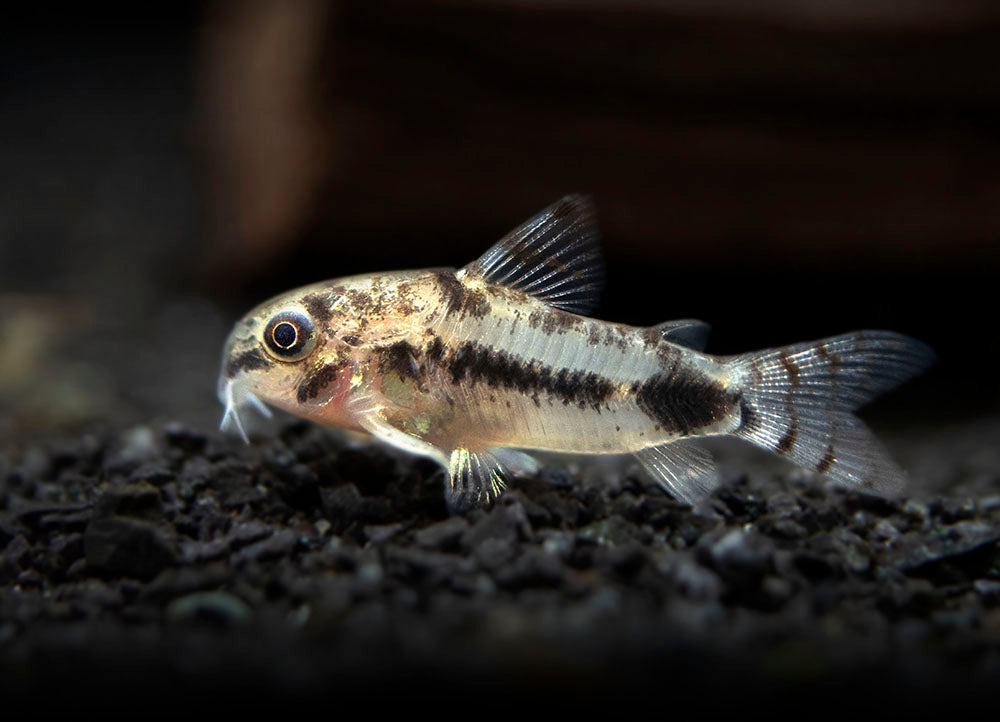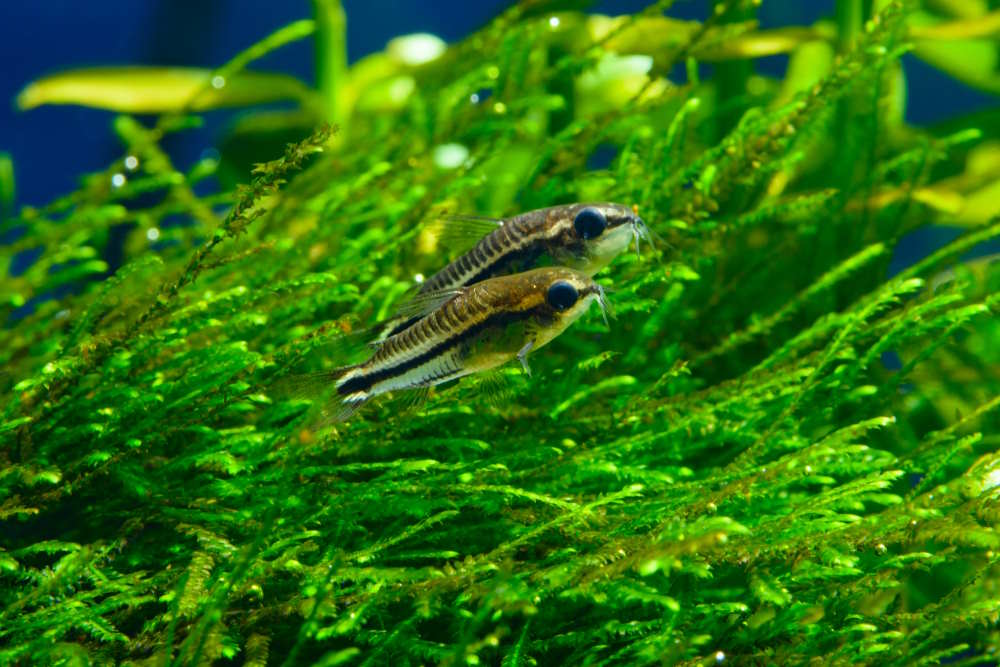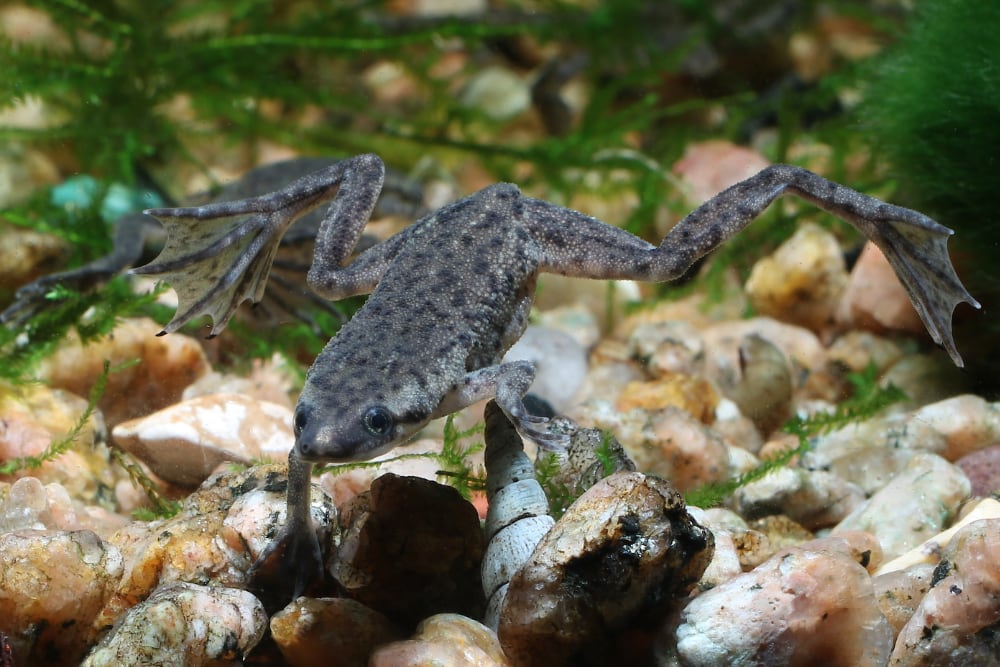Care Guide for Otocinclus Catfish — Peaceful, Schooling Algae Eater
If you start getting algae in your new fish tank, most major pet stores will recommend that you buy a pleco or suckermouth catfish. The problem is that most plecos grow rather large, especially the common pleco that can reach up to 2 feet (60 cm). Instead, why not get their much smaller cousin, the otocinclus catfish? They are the perfect fish that have a peaceful personality and amazing cleaning skills. Learn how to keep these adorable algae-eaters and make sure they’re getting enough to eat.
What are Otocinclus Catfish?
This genus of South American catfish consists of about 20 species so far and are often referred to as “otos” for short. Common species in the aquarium hobby include O. vittatus (common otocinclus), O. macrospilus (dwarf otocinclus), and O. cocama (zebra oto). Otocinclus typically range from 1.5–2 inches (4–5 cm), and many kinds are known for having a black horizontal line, dark grayish-brown back, and white belly. Unlike many catfish, they are diurnal (or awake during the daytime). They can usually be found grazing or resting on the ground and flat surfaces (e.g., plant leaves, hardscape, and tank walls) until they suddenly zip away to the other side of the tank.
Are otocinclus good algae eaters? These little critters love nothing more than to nibble algae off plants, glass, tank decor, and other smooth surfaces. They specialize in eating softer algae such as soft green algae and brown diatoms and tend to avoid harder types like black beard or green spot algae. They also love to eat the biofilm that grows on driftwood and other botanicals that are slowly breaking down in the aquarium.

Otocinclus perched on an aquarium plant
How to Purchase Otocinclus Catfish
Otocinclus have a reputation for being sensitive fish that are hard to keep alive, but experienced aquarists will tell you that otos are actually very resilient fish and they often avoid catching common illnesses that plague other fish. Their greatest weakness is not getting enough to eat. Currently, most otocinclus are caught from the wild and sent to an exporter’s warehouse, where they are fasted for several days so that they won’t produce too much waste when they are shipped out. Then they arrive at a wholesaler, and hundreds of them are put into a bare aquarium where they may spend a few weeks without getting enough food. By the time the fish store buys the otos from the wholesaler, the fish may not have eaten well for the past 3–6 weeks and will come in pretty skinny.
Even through all that stress, there’s a good chance that otocinclus can still thrive in your aquarium if you follow a few simple tips to greatly increase their survivability:
- Make sure you have tons of algae in an aquarium for them to pig out on when you bring them home. The best way to accomplish this is to set up a quarantine tank and simply leave the light on for a week or so until algae is growing all over the place.
- Go buy the otos the day after they come into the pet or fish store. This goes against conventional wisdom which says that you want to buy fish that have been at the pet store longer to prove their longevity and lessen the shock of being transported too soon after arrival. Given that the otocinclus are typically grouped together in large numbers and put into tanks that can’t produce enough algae, you want to pick out the strongest fish and take them home to pamper as soon as possible.
- Pick the healthiest otos with round, pearly abdomens that are happily swimming around and feeding in the tank. The problem with scrawny otocinclus catfish is that once they have been starved of food, it is often hard to get them to eat again.
- Besides algae, try offering them lots of different kinds of foods to see what they’ll eat. See the below section on dietary requirements for more ideas.
You know you have achieved success in finding a good food balance for your otos if they have lived in your tank for more than a month or two. Once your fish have survived that long, it means they are getting enough food to continue happily navigating their new home.
3 healthy otocinclus with rounded, pearl-like bellies
How to Set Up an Aquarium for Otocinclus
Otos are relatively hardy in terms of water parameters and can live in fish tanks with temperatures between 70-79°F (21-26°C), pH of 6.0–7.5, and soft to hard water. As mentioned before, they do best in a mature aquarium with lots of algae and biofilm, especially one that is planted and has plenty of hiding spots. In fact, when we collected fish in Peru, we often found them by lifting up pieces of wood from the water, so they probably feel safer there and like foraging on the driftwood for microfauna. The rivers we found them in were murky with silt and tannins, so some hobbyists like to dim the lights or add catappa leaves to tint the water. Consider getting slow-growing plants with flat leaves that are known to be algae-magnets, such as Anubias barteri. Also, we tend to only scrape off algae from the front aquarium panel so that it can grow on the other three walls and provide more food for the otos.
How many otocinclus should be kept together? Usually, we suggest keeping schooling fish in as large of a group as possible, but the problem with otocinclus is that too many of them may end up consuming all the algae in the aquarium. It is much better to have a couple of plump and healthy otos than a school of six that are slowly starving to death over time. The best thing you can do is to not overstock the tank with otocinclus (and other algae eaters) to make sure there’s enough algae and food to go around.
What fish can live with otocinclus? Otocinclus don’t have a mean bone in their bodies and are well-suited for peaceful community setups. Avoid any aggressive species that will pick on them or are large enough to eat them. Instead, choose other similar-sized, docile tank mates that won’t outcompete them for food — such as tetras, rasboras, corydoras, kuhli loaches, snails, and dwarf shrimp. While all fish will opportunistically eat whatever can fit in their mouths, we have even housed our otos with baby fish and shrimp and experienced minimal casualties.

Otocinclus hanging out with a school of blackline tetras
What Do Otocinclus Catfish Eat?
The reason why otocinclus have such specialized dietary requirements is because they are aufwuchs grazers that primarily suck off the slimy layer that grows on underwater plants and hardscape. This biofilm is made up of algae, diatoms, insect larvae, tiny crustaceans, and other microorganisms. That is why otos don’t tend to take to flake foods, pellets, or other normal community fish foods. Instead, they need foods that allow them to constantly graze, last for a long time in the water without breaking apart, and won’t be immediately gulped down by other species.
Not every oto eats the same thing, so keep trying different foods to see what they like — like canned green beans, algae wafers, and softened zucchini slices that have been blanched (or slightly boiled) and sitting in the aquarium water for more than 24 hours. One of our favorite foods to feed them is Repashy Soilent Green gel food, which is specially formulated for aufwuchs grazers. Just stir the powder in hot water, and while the mixture is still runny, paint it or spoon it onto a round rock or piece of driftwood. In fact, don’t forget to add driftwood and catappa leaves into their tank (even without Repashy gel food) because otos like to graze on the natural biofilm that forms as the plant fibers break down. You can tell when they are full because their bellies look like a round, white pearl.

Oto munching on a slice of zucchini
How to Breed Otocinclus Catfish
In general, otocinclus have breeding behaviors that are very similar to corydoras catfish. The females are a little bigger and broader than males, especially when they are full of eggs. To condition them for spawning, feed them lots of their normal foods and introduce more protein in their diet — such as live and frozen baby brine shrimp and micro worms. Some hobbyists try to induce breeding by doing 50% water changes to imitate seasonal flooding and heavy rainfall. Like cory catfish, the mating pair forms a T position and then the female lays adhesive eggs on plant leaves and other surfaces. These clutches of 30–40 eggs should be removed or they may get eaten by other fish. Sometimes the eggs can be extremely sticky and hard to roll off.
Put the eggs into a hatching container with an air stone and wait about 3 days for the fry to hatch. The fry can be fed green water, soft algae that grows on surfaces, spirulina powder, live paramecium, soft vegetables, and tiny, 5–50 micron powdered fry foods. Eventually, you can add live baby brine shrimp to their diet for faster growth. Because of their miniscule size, make sure to use gentle flow with a sponge filter or block the intake tube of your filter with a pre-filter sponge.

Zebra or tiger otocinclus (O. cocama)
Otocinclus catfish are the sweetest, little fish to add to your planted community tank, and if you invest some love and care, they will happily thrive for years.
Source: https://www.aquariumcoop.com/blogs/aquarium/otocinclus-catfish












